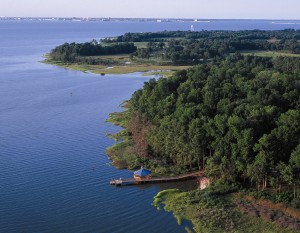An Exciting New Vision for the Future
excerpts from the Suffolk News Herald ~ by Tracy AgnewOn a hot summers day, children splash in a memorial pool that commemorates the historic Battle of the Ironclads. In the background, wind turbines spin and traffic rushes by on the Monitor-Merrimac Memorial Bridge-Tunnel.Nearby, researchers are working, men are mowing their lawns and cash registers are ringing. Old college friends meet for lunch and shopping, families come for entertainment and young professionals come home from work to their new apartments.This is the concept developed by an Urban Land Institute panel for a 444-acre site in North Suffolk, currently owned by the citys Economic Development Authority and the Tidewater Community College Real Estate Foundation. The TCC property is the former site of the colleges Portsmouth campus. Another portion of the site is the former Nansemond Ordnance Depot.The panel spent five days in Suffolk touring the city and the site, interviewing stakeholders and formulating a recommendation. The consultants came up with a comprehensive mixed-use plan for the site, which is tentatively called Confluence Point, a reference to the fact that the Nansemond and James rivers come together along the edge of the property. The proposed plan includes retail space, office buildings, restaurants, hotels, a variety of residences and public use space.This is the best property in Hampton Roads, said Allen Folks, one of the panelists who visited the city. This is Suffolks moment. This is your time.The city and the college spent $60,000 each to bring the group to town.The panel considered the locations benefits the large site, the areas rich history, its gateway location, the waterfront property and more. But the property also has challenges its an active Superfund site, there are large, unusable buildings, theres limited potential for expansion and the possibility of shoreline erosion and archeological finds exists.In its recommendation, the group suggested a wide variety of uses 1.3 million square feet of office space for research and development for medical and military uses; 500,000 square feet of retail, restaurants, hotels, entertainment venues and highway-oriented space; and 2,100 units of apartments, townhomes, condominiums and houses. The plan uses about 319 of the available 444 acres.After conducting extensive market research, the panel determined that the areas real estate market which currently has excess capacity in all categories would be in a position to handle the additional space in five to seven years.The group presented a number of design options for the plan. A few things remained the same throughout, though interconnected streets, walkability, well-designed landscapes and generous public use space.All of the plans call for a public, high-impact waterfront area.A waterfront promenade would expand to a step-down amphitheater that extends all the way to the water. There also would be new docks and possibly fishing piers. Wind turbines off the riverbanks would provide a wind energy testing site.Near the amphitheater, a water feature would incorporate a commemoration of the Civil War battle of the ironclad ships Monitor and Merrimac, which occurred in the river very close to Confluence Point. The 4-inch-deep water pool would feature the footprint of each ship with informative plates on each. Jets of water would erupt spontaneously from around the ships to simulate a battle.At another location along the riverfront, the panel proposed a nature center that would incorporate a sand beach, kayak access and more.Once the panel was done presenting its suggestions, it provided extensive advice on developing, marketing and financing the project.There are a number of avenues to market the site, panel member Sue Southon said.Among the suggestions hire a development manager or firm, create a joint operating agreement between the city and the college foundation, craft a dynamic, informative website and clear a portion of the wooded land to make it easier to imagine an office building there.Funding strategies could include bonds, selling a small portion of the land not suited for development, seeking state and federal grant funds and more.This is not going to be easy, but if done properly, its going to be great, panel member Donna Lewis said.


